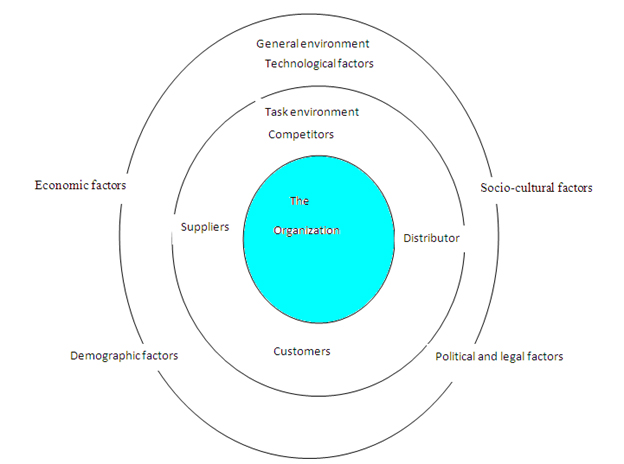Managing in Global Environment (Managerial Function)
With fast development in business field, management environments are becoming more diverse and multifaceted. Global Organizations are those which operate and compete in more than one country. These are uncertain and unpredictable. The global environment of such companies is a set of forces and conditions exterior of the organization's boundaries that affects the way it operates and shapes its behaviour. These forces alter over time and therefore present global managers have to get many opportunities as well as threats.
To recognize opportunities or threats due to global environmental forces, it is necessary that managers must differentiate between the task environment and the more surrounding general environment. The task environment is the set of forces and conditions that affect an organization's ability to obtain inputs and dispose of its outputs. It consists of the organization's suppliers, customers, distributors, and competitors, and has the most immediate and direct effect on managers. Suppliers are individuals and organizations that provide an organization with the input resources that it needs to produce goods and services such as raw materials, component parts, and employees. In global environment, relationships with suppliers can be complicated due to materials shortages, unions, and lack of substitutes. Suppliers who are the only source of a critical item are in a strong bargaining position to raise their prices. Managers can reduce these supplier effects by increasing the number of suppliers of an input. Another element of task environment is distributors. These are organizations that help other organizations sell their goods or services to customers. Powerful distributors can limit access to markets through its control of customers in that market. Customers purchase the goods and services that an organization produces. Identifying an organization's main customers and producing the goods and services they want is vital to organizational and managerial victory. Competitors also affect the global environment of firms. Competitors manufacture goods and services that are comparable to a particular organization's merchandise and services. Strong competitive enmity results in price competition, and falling prices reduce access to resources and lower profits.
The general environment includes the wide-ranging economic, technological, socio-cultural, demographic, political and legal, and global forces that affect the organization and its task environment. Economic Forces include interest rates, inflation, unemployment, economic expansion and other factors that affect the general health and well-being of a nation or the regional economy of an organization. Technological Forces that affect global environment are outcomes of changes in the technology that managers use to design, produce, or distribute goods and services. Sociocultural Forces are pressures emanating from the social structure of a country or society or from the national culture. Demographic Forces are result of change in, or changing attitudes toward, the characteristics of a population, such as age, gender, ethnic origin, race, sexual orientation, and social class. Most developed nations are experiencing the aging of their populations. Political and Legal Forces are outcomes of changes in laws and regulations, such as the deregulation of industries, the privatisation of organizations, and increased emphasis on environmental protection.
Forces and factors in global environment

It can be established that organizations must create a global framework for environmental management and set targets and geographically implement action plans in all areas of its activity, from production and technical development, manufacturing, marketing and sales to other divisions. To perform its global environmental management, company must adopt an organizational approach linking its various functions and regions.
To summarize, area of global companies includes its goods and services and its customers. Companies must cope up with forces in the specific and general environments. Specific environmental forces comprises of outside stakeholder groups that directly impact the ability to obtain resources like customers, distributors, unions, the government, competitors, and suppliers. General environmental forces are economic, international, technological, demographic and cultural, political, and environmental forces. Complexity, dynamism, and richness determine the extent of environmental uncertainty. A simple, steady and affluent environment has some ambiguity, but a multifaceted, dynamic, poor environment is highly uncertain. Management researchers stated that the global marketplace create uncertain environment.
Please go through Questions papers in Management for actual questions given in the mains paper by UPSC.

